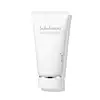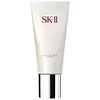What's inside
What's inside
 Key Ingredients
Key Ingredients

 Benefits
Benefits

 Concerns
Concerns

 Ingredients Side-by-side
Ingredients Side-by-side

Water
Skin ConditioningCaprylic/Capric Triglyceride
MaskingSodium Cocoyl Isethionate
CleansingGlycerin
HumectantOlea Europaea Fruit Oil
MaskingLauryl Hydroxysultaine
CleansingLauric Acid
CleansingGlycol Distearate
EmollientC14-22 Alcohols
Emulsion StabilisingSodium Chloride
MaskingSodium Methyl Cocoyl Taurate
CleansingCI 77891
Cosmetic ColorantLauryl Glucoside
CleansingParfum
MaskingDisodium Cocoamphodiacetate
Cleansing1,2-Hexanediol
Skin ConditioningTrehalose
HumectantC12-20 Alkyl Glucoside
EmulsifyingPolyquaternium-7
Benzyl Salicylate
PerfumingEthylhexylglycerin
Skin ConditioningPropanediol
SolventEctoin
Skin ConditioningCitronellol
PerfumingLimonene
PerfumingSodium Benzoate
MaskingArginine
MaskingAspartic Acid
MaskingGlutamic Acid
HumectantNiacinamide
SmoothingBioflavonoids
Skin ConditioningHydroxypropyl Cyclodextrin
MaskingButylene Glycol
HumectantMethoxy PEG-114/Polyepsilon Caprolactone
BufferingHydrolyzed Proanthocyanidin
AntioxidantHydrolyzed Ginseng Saponins
Skin ConditioningPhenoxyethanol
PreservativeCaprylyl Glycol
EmollientTocopherol
AntioxidantAcetyl Heptapeptide-4
HumectantRehmannia Glutinosa Root Extract
Skin ConditioningPaeonia Lactiflora Root Extract
Skin ConditioningPolygonatum Odoratum Rhizome Extract
Skin ConditioningNelumbo Nucifera Flower Extract
Skin ConditioningPanax Ginseng Berry Extract
Skin ConditioningLilium Tigrinum Extract
Skin ConditioningAcetyl Hexapeptide-8
HumectantSodium Hydroxide
BufferingAcetyl Octapeptide-3
HumectantWater, Caprylic/Capric Triglyceride, Sodium Cocoyl Isethionate, Glycerin, Olea Europaea Fruit Oil, Lauryl Hydroxysultaine, Lauric Acid, Glycol Distearate, C14-22 Alcohols, Sodium Chloride, Sodium Methyl Cocoyl Taurate, CI 77891, Lauryl Glucoside, Parfum, Disodium Cocoamphodiacetate, 1,2-Hexanediol, Trehalose, C12-20 Alkyl Glucoside, Polyquaternium-7, Benzyl Salicylate, Ethylhexylglycerin, Propanediol, Ectoin, Citronellol, Limonene, Sodium Benzoate, Arginine, Aspartic Acid, Glutamic Acid, Niacinamide, Bioflavonoids, Hydroxypropyl Cyclodextrin, Butylene Glycol, Methoxy PEG-114/Polyepsilon Caprolactone, Hydrolyzed Proanthocyanidin, Hydrolyzed Ginseng Saponins, Phenoxyethanol, Caprylyl Glycol, Tocopherol, Acetyl Heptapeptide-4, Rehmannia Glutinosa Root Extract, Paeonia Lactiflora Root Extract, Polygonatum Odoratum Rhizome Extract, Nelumbo Nucifera Flower Extract, Panax Ginseng Berry Extract, Lilium Tigrinum Extract, Acetyl Hexapeptide-8, Sodium Hydroxide, Acetyl Octapeptide-3
Water
Skin ConditioningGalactomyces Ferment Filtrate
HumectantButylene Glycol
HumectantPolysorbate 20
EmulsifyingGlycerin
HumectantSodium Hyaluronate
HumectantPEG-150
HumectantCellulose Gum
Emulsion StabilisingDisodium EDTA
Citric Acid
BufferingSalicylic Acid
MaskingLactic Acid
BufferingMalic Acid
BufferingSodium Citrate
BufferingSodium Benzoate
MaskingMethylparaben
PreservativeIllite Extract
Skin Conditioning
 Reviews
Reviews

Ingredients Explained
These ingredients are found in both products.
Ingredients higher up in an ingredient list are typically present in a larger amount.
Butylene Glycol (or BG) is used within cosmetic products for a few different reasons:
Overall, Butylene Glycol is a safe and well-rounded ingredient that works well with other ingredients.
Though this ingredient works well with most skin types, some people with sensitive skin may experience a reaction such as allergic rashes, closed comedones, or itchiness.
Learn more about Butylene GlycolGlycerin is already naturally found in your skin. It helps moisturize and protect your skin.
A study from 2016 found glycerin to be more effective as a humectant than AHAs and hyaluronic acid.
As a humectant, it helps the skin stay hydrated by pulling moisture to your skin. The low molecular weight of glycerin allows it to pull moisture into the deeper layers of your skin.
Hydrated skin improves your skin barrier; Your skin barrier helps protect against irritants and bacteria.
Glycerin has also been found to have antimicrobial and antiviral properties. Due to these properties, glycerin is often used in wound and burn treatments.
In cosmetics, glycerin is usually derived from plants such as soybean or palm. However, it can also be sourced from animals, such as tallow or animal fat.
This ingredient is organic, colorless, odorless, and non-toxic.
Glycerin is the name for this ingredient in American English. British English uses Glycerol/Glycerine.
Learn more about GlycerinSodium Benzoate is a preservative. It's used in both cosmetic and food products to inhibit the growth of mold and bacteria. It is typically produced synthetically.
Both the US FDA and EU Health Committee have approved the use of sodium benzoate. In the US, levels of 0.1% (of the total product) are allowed.
Sodium benzoate works as a preservative by inhibiting the growth of bacteria inside of cells. It prevents the cell from fermenting a type of sugar using an enzyme called phosphofructokinase.
It is the salt of benzoic acid. Foods containing sodium benzoate include soda, salad dressings, condiments, fruit juices, wines, and snack foods.
Studies for using ascorbic acid and sodium benzoate in cosmetics are lacking, especially in skincare routines with multiple steps.
We always recommend speaking with a professional, such as a dermatologist, if you have any concerns.
Learn more about Sodium BenzoateWater. It's the most common cosmetic ingredient of all. You'll usually see it at the top of ingredient lists, meaning that it makes up the largest part of the product.
So why is it so popular? Water most often acts as a solvent - this means that it helps dissolve other ingredients into the formulation.
You'll also recognize water as that liquid we all need to stay alive. If you see this, drink a glass of water. Stay hydrated!
Learn more about Water